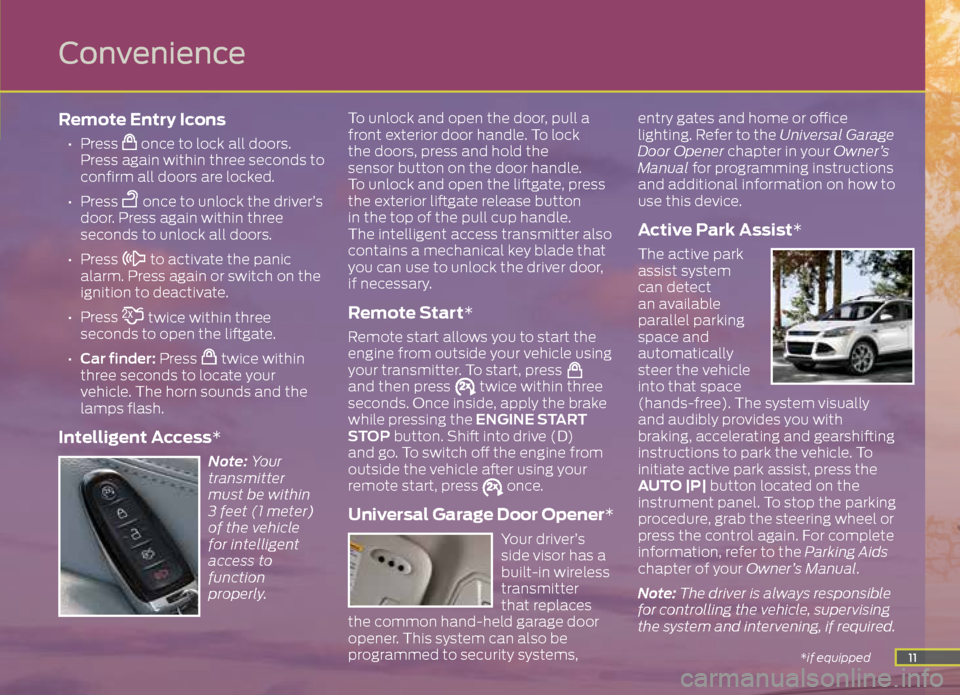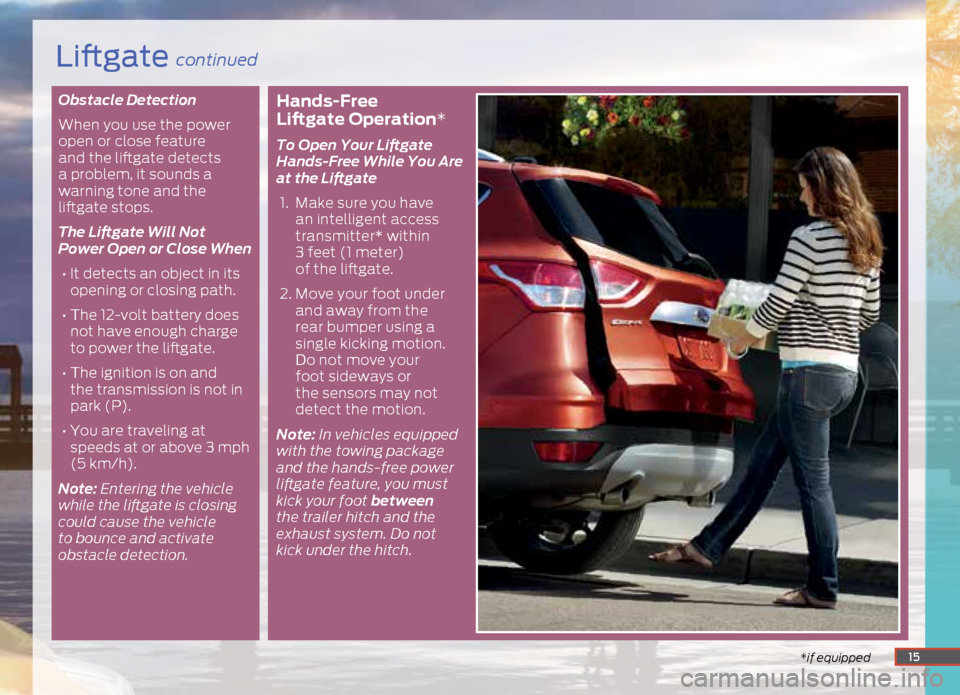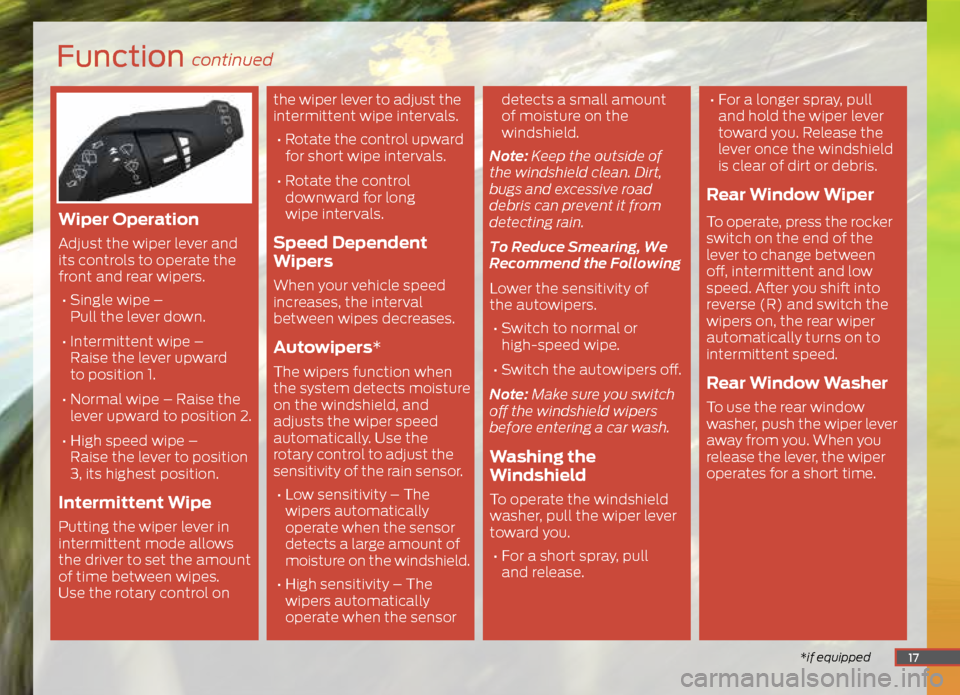sensor FORD ESCAPE 2015 3.G Quick Reference Guide
[x] Cancel search | Manufacturer: FORD, Model Year: 2015, Model line: ESCAPE, Model: FORD ESCAPE 2015 3.GPages: 20, PDF Size: 2.45 MB
Page 12 of 20

11
Remote Entry Icons
• Press once to lock all doors.
Press again within three seconds to
confirm all doors are locked.
• Press
once to unlock the driver’s
door. Press again within three
seconds to unlock all doors.
• Press
to activate the panic
alarm. Press again or switch on the
ignition to deactivate.
• Press
twice within three
seconds to open the liftgate.
• Car finder: Press
twice within
three seconds to locate your
vehicle. The horn sounds and the
lamps flash.
Intelligent Access*
Note: Your
transmitter
must be within
3 feet (1 meter)
of the vehicle
for intelligent
access to
function
properly. To unlock and open the door, pull a
front exterior door handle. To lock
the doors, press and hold the
sensor button on the door handle.
To unlock and open the liftgate, press
the exterior liftgate release button
in the top of the pull cup handle.
The intelligent access transmitter also
contains a mechanical key blade that
you can use to unlock the driver door,
if necessary.
Remote Start*
Remote start allows you to start the
engine from outside your vehicle using
your transmitter. To start, press
and then press twice within three
seconds. Once inside, apply the brake
while pressing the ENGINE START
STOP button. Shift into drive (D)
and go. To switch off the engine from
outside the vehicle after using your
remote start, press
once.
Universal Garage Door Opener*
Your driver’s
side visor has a
built-in wireless
transmitter
that replaces
the common hand-held garage door
opener. This system can also be
programmed to security systems, entry gates and home or office
lighting. Refer to the Universal Garage
Door Opener chapter in your Owner’s
Manual for programming instructions
and additional information on how to
use this device.
Active Park Assist*
The active park
assist system
can detect
an available
parallel parking
space and
automatically
steer the vehicle
into that space
(hands-free). The system visually
and audibly provides you with
braking, accelerating and gearshifting
instructions to park the vehicle. To
initiate active park assist, press the
AUTO |P| button located on the
instrument panel. To stop the parking
procedure, grab the steering wheel or
press the control again. For complete
information, refer to the Parking Aids
chapter of your Owner’s Manual.
Note: The driver is always responsible
for controlling the vehicle, supervising
the system and intervening, if required.
*if equipped
Convenience
Page 16 of 20

Obstacle Detection
When you use the power
open or close feature
and the liftgate detects
a problem, it sounds a
warning tone and the
liftgate stops.
The Liftgate Will Not
Power Open or Close When• It detects an object in its
opening or closing path.
• The 12-volt battery does
not have enough charge
to power the liftgate.
• The ignition is on and
the transmission is not in
park (P).
• You are traveling at
speeds at or above 3 mph
(5 km/h).
Note: Entering the vehicle
while the liftgate is closing
could cause the vehicle
to bounce and activate
obstacle detection.Hands-Free
Liftgate Operation*
To Open Your Liftgate
Hands-Free While You Are
at the Liftgate
1. Make sure you have
an intelligent access
transmitter* within
3 feet (1 meter)
of the liftgate.
2. Move your foot under
and away from the
rear bumper using a
single kicking motion.
Do not move your
foot sideways or
the sensors may not
detect the motion.
Note: In vehicles equipped
with the towing package
and the hands-free power
liftgate feature, you must
kick your foot between
the trailer hitch and the
exhaust system. Do not
kick under the hitch.
*if equipped*if equipped15
Liftgate continued
Page 18 of 20

Function continued
*if equipped
Wiper Operation
Adjust the wiper lever and
its controls to operate the
front and rear wipers.
• Single wipe –
Pull the lever down.
• Intermittent wipe –
Raise the lever upward
to position 1.
• Normal wipe – Raise the
lever upward to position 2.
• High speed wipe –
Raise the lever to position
3, its highest position.
Intermittent Wipe
Putting the wiper lever in
intermittent mode allows
the driver to set the amount
of time between wipes.
Use the rotary control on the wiper lever to adjust the
intermittent wipe intervals.
• Rotate the control upward
for short wipe intervals.
• Rotate the control
downward for long
wipe intervals.
Speed Dependent
Wipers
When your vehicle speed
increases, the interval
between wipes decreases.
Autowipers*
The wipers function when
the system detects moisture
on the windshield, and
adjusts the wiper speed
automatically. Use the
rotary control to adjust the
sensitivity of the rain sensor.
• Low sensitivity – The
wipers automatically
operate when the sensor
detects a large amount of
moisture on the windshield.
• High sensitivity – The
wipers automatically
operate when the sensor detects a small amount
of moisture on the
windshield.
Note: Keep the outside of
the windshield clean. Dirt,
bugs and excessive road
debris can prevent it from
detecting rain.
To Reduce Smearing, We
Recommend the Following
Lower the sensitivity of
the autowipers.
• Switch to normal or
high-speed wipe.
• Switch the autowipers off.
Note: Make sure you switch
off the windshield wipers
before entering a car wash.
Washing the
Windshield
To operate the windshield
washer, pull the wiper lever
toward you. • For a short spray, pull
and release.
• For a longer spray, pull
and hold the wiper lever
toward you. Release the
lever once the windshield
is clear of dirt or debris.
Rear Window Wiper
To operate, press the rocker
switch on the end of the
lever to change between
off, intermittent and low
speed. After you shift into
reverse (R) and switch the
wipers on, the rear wiper
automatically turns on to
intermittent speed.
Rear Window Washer
To use the rear window
washer, push the wiper lever
away from you. When you
release the lever, the wiper
operates for a short time.
17
Page 20 of 20

Towing Your Escape
Towing your vehicle behind
an RV or any other vehicle
may be limited. Refer to
Towing the Vehicle on
Four Wheels section in the
Towing chapter of your
Owner’s Manual.
Tire Pressure
Monitoring System
Your vehicle shows a low
tire pressure warning light in your instrument
cluster when one or more
of your tires are significantly
under-inflated. If this
happens, stop and check
your tires as soon as
possible. Inflate them to
the proper pressure.
Refer to the Inflating Your
Tires section in the Wheels
and Tires chapter of
your Owner’s Manual for
more information.
Fuel-efficient
Transmission
Your vehicle has been
designed to improve fuel
economy by reducing fuel
usage while coasting or
decelerating. This may
be perceived as a light to
medium braking sensation
when removing your foot
from the accelerator pedal.
Rear Window Buffeting
You may hear a pulsing
noise when just one of the
windows is open. Lower the
opposite window slightly to
reduce this noise. Press the
switch to open the window.
Lift the switch to close
the window.
Front and Rear
Sensing System*
This system sounds an
audible warning tone if
there is an obstacle near
the vehicle’s front or rear
bumpers. As the vehicle
moves closer to the
obstacle, the rate of the
warning tone increases
in frequency. The front
sensors are automatically
activated when the vehicle
is in drive (D) and the
vehicle speed is below
6 mph (10 km/h). The
system can detect
objects up to 27 inches
(70 centimeters) away
from the front of the
vehicle and about 14 inches
(35 centimeters) to the
side of the front end.
Essential Information continued
The rear sensors are active
only when the vehicle is
in reverse (R), and can
detect objects up to 6 feet
(1.8 meters) away, with
decreased coverage at
the outer corners of the
bumper). See the Parking
Aids chapter in your Owner’s
Manual for complete
information on your
vehicle’s sensing systems.
Note: Visibility aids do
not replace the need to
watch where the vehicle
is moving. Refer to your
Owner’s Manual for safety
information, more details
and limitations.
Roadside Assistance
Your new Ford vehicle
comes with the assurance
and support of 24-hour
emergency roadside
assistance. To receive
roadside assistance in
the United States, call
1-800-241-3673.
In Canada, call
1-800-665-2006.
19*if equipped